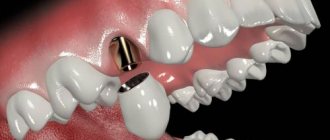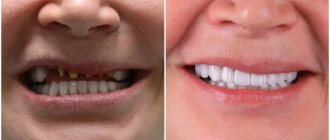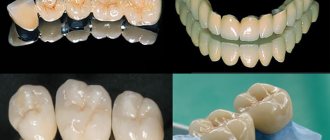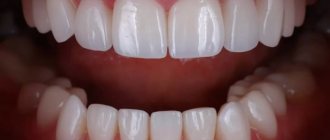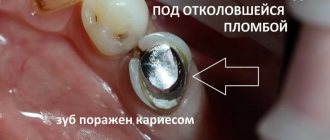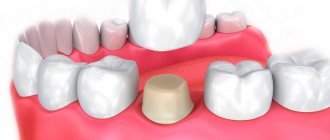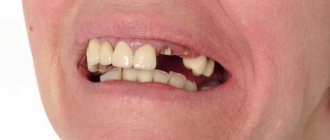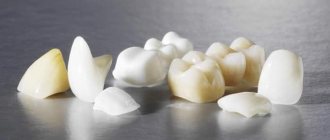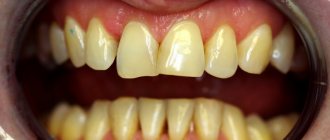Healthy teeth are the key to a beautiful smile and self-confidence. Proper cleaning alone is often not enough. The reason for visiting the clinic may be the removal of tartar, improving the aesthetics of the oral cavity, as well as a number of other reasons. One of the most common and widely popular types of procedures in dentistry is the installation of dental crowns.
This type of prosthetics requires at least two visits to the doctor. During the first consultation, the tooth is examined and prepared. During this procedure, an impression is made to create the crown of the tooth, and a temporary filling is placed to protect it. During the second visit, after the dental laboratory has fabricated the appropriate prosthesis, the temporary filling is removed, a custom-made permanent filling is placed and secured in place.
In some cases, it may be necessary to make an abutment (part of a dental implant) that provides reliable fixation of the pin that replaces the tooth root with the crown.
In what cases is it necessary to install a denture?
The reason for installing a crown may be severe tooth decay due to caries.
This prosthetic procedure provides more advantages compared to filling. The fact is that large fillings do not withstand the chewing load well, which can lead to the filling falling out or breaking, and along with it, tooth breakage can occur. In this case, if the tooth root is damaged, it will have to be removed. Installing a crown on a tooth destroyed by caries provides an opportunity to save it.
Tooth destruction as a result of injury, if the roots were not affected, can also be a reason for installing a crown.
The need for the procedure may also be associated with aesthetic restoration in case of a chipped tooth. The installation of temporary dentures is indicated for patients with periodontitis, which prevents loosening and tooth loss.
Metal-ceramic crowns –
Such crowns have a metal frame 0.3-0.5 mm thick inside, which is lined with layers of ceramic mass (porcelain) on the outside. In the budget version, the metal frame is made by casting from CHS (cobalt-chromium alloy), but it is also possible to manufacture the frame from alloys of precious metals - such as gold and platinum. Although in this option the cost of 1 Unit of metal ceramics will already be equal to the cost of metal-free ceramics, and at the same time it will still be inferior to it in aesthetics.
The advantages of metal-ceramic prosthetics include high strength, fairly good aesthetics, and, in a budget version, also an acceptable cost. The disadvantages are: 1) the need to grind off a large amount of tooth tissue, 2) the need to depulp teeth, 3) the appearance of cyanosis of the gums around the crown, 4) over time, gum recession may occur, and as a result, the edge of the metal frame may begin to peek out from under the gums. The last two points are especially critical when it comes to crowns on the front teeth - especially in patients with a “gummy type of smile.”
Metal-ceramic crowns: photo
A sharp blueness of the gums and the edge of the metal frame peeking out from under the gums can make the aesthetics unsatisfactory, although this may not be important when it comes to prosthetics of the chewing group of teeth. These problems arise due to the fact that the metal frame of metal ceramics in the standard version is lined with porcelain on all sides (but with the exception of the lower edge, which will be in contact with the gum). And therefore, the thinner the patient’s gum thickness, the more the metal will shine through it, giving it a bluish color.
This can be avoided by using “metal-ceramics with shoulder mass”. For such crowns, the lower edge of the metal frame will also be lined with porcelain, but due to the complexity of manufacturing, this option will cost + 5,000 rubles to the price of 1 Unit in the standard version. But if you decide to opt for metal-ceramics, then you need to pay great attention to what ceramic mass will be used to make your crowns.
The cost of a metal-ceramic crown is
One crown, made from good budget ceramics “Duceram” (Germany) and high-quality cobalt-chromium alloy, will cost an average of 12,000 rubles per 1 Unit. At the same time, if ceramic masses of a higher level are used (allowing one to achieve really good aesthetics), the price in clinics of the middle price category will already be from 15,000 to 18,000 rubles. Examples of manufacturers of high-quality ceramic masses are (Liechtenstein), Vita (Germany), Noritake (Japan).
And usually this is always indicated in clinic price lists (for example, “Ivoclar metal-ceramic crown”). Because each of these manufacturers produces ceramic masses of different levels, we will indicate their more detailed names, and the best ones are “Ivoclar - IPS InLine”, “Noritake EX-3”, “Vita VMK Master”, as well as “Creation” and "Initial". But remember that a good ceramic mass is only half the success (the ability to achieve good aesthetics). The second half is a good, talented dental technician, of whom not everyone is capable of making metal-ceramics similar in color and transparency to the adjacent real teeth.
What other extra charges might there be? –
If you want metal ceramics with shoulder mass, then you will have to pay about 5,000 rubles in addition to the cost of 1 Unit. Metal ceramics based on gold-palladium or gold-platinum alloy will cost approximately 25,000 rubles + the cost of gold (+ 5,000 rubles per gram). Together with the cost of gold, 1 crown will cost approximately 32,000 rubles. Remember that all prices above do not include preparation of teeth for prosthetics, production of temporary crowns made of plastic.
Another option is that the metal frame can be made from CHS, but not by solid casting, but by milling on a computer-controlled machine (CAD/CAM technology). This is a much more precise option for making frameworks, but it is only really important when it comes to metal-ceramic bridges over long distances. Because Since this article is only a review, we have briefly outlined the most important criteria when choosing metal-ceramics, and you can read more about this type of crown at the link above.
Manufacturing technologies
There are various technologies for making crowns. All varieties are made in accordance with an impression that is taken from the tooth requiring restoration. In the dental laboratory, a model is created, on the basis of which permanent fixation prostheses are produced.
Various technologies are used to create them.
Creating dentures using the stamping method is currently used less frequently than other options. The decline in popularity of this method is due to the fact that crowns made using this technique are not always anatomically accurate and completely coincide with the patient’s tooth. An anatomically inaccurate crown, when installed, does not fit tightly to the tooth tissue, due to which bacteria penetrate under it, caries and other diseases develop.
Technology using casting techniques ensures the creation of more durable, high-quality crowns that fit tightly to the tooth tissue. The development of caries is reduced to a minimum, and the reliability and useful life of such a prosthesis increases.
Recently, computer technology for creating crowns has become widespread. However, it is necessary to understand that the model of the future crown is formed based on the key parameters set by the orthopedic dentist. Therefore, the quality of the manufactured structure depends on the qualifications of the specialist.
When it cannot be installed
Unfortunately, in medicine there is no universal treatment method that would suit everyone without exception. Before placing a crown on a tooth, discuss possible contraindications with your doctor:
- the presence of inflammatory processes in the acute stage (common stomatitis, periodontitis, pulpitis and other diseases, for example, periodontal disease and gingivitis);
- malocclusion.
Varieties
The difference in tissues from which dental crowns are created depends on the type of teeth:
- More attention is paid to the front teeth; it is important for patients to obtain an aesthetically pleasing result with a natural color, since they are the focus of attention when communicating;
- on chewing teeth, it is possible to use cheap and simple materials, especially when located far away; however, the structure must be durable to bear the chewing load.
Additional information: children of the nineties remember the golden bridges that adults flaunted, including on the visible row - a symbol of prosperity and wealth. Professional dentistry has long moved away from “jewelry” in the production of prosthetics, however, according to reviews on the Internet, this method of prosthetics is still found in settlements remote from the center.
Metal
Metal is suitable for crowns on chewing teeth because of its strength to withstand the daily stress of eating food. An older and less applicable method of tooth replacement.
Titanium construction is a hypoallergenic installation that causes a lower percentage of rejection.
The lack of visual aesthetics reduces the popularity of such systems, however, customers are attracted by the low cost and durability.
Metal ceramics
A metal-ceramic tooth crown is a frame made of precious metals (gold, platinum, palladium) and an outer ceramic “case” to give a natural look to the new denture.
Porcelain veneer is selected in accordance with the color of the dentition, so as not to differ from its neighbors and at the same time be highly durable and wearable for up to 15 years.
A popular type of restoration that provides a guaranteed result at a relatively low cost.
Advantages:
- durability;
- suitable for 99% of those who seek help;
- safety due to hypoallergenic raw materials.
Only ceramics
A ceramic crown is suitable for fixing to a tooth in the smile area - a place where a person does not make chewing movements, since ceramics are strong, but not strong enough for constant pressure.
The structure on the metal frame “shines through” the metal, thereby increasing the yellowness and reducing the beauty of the altered tooth. When installed without a metal structure, there will be nothing to “shine through”.
Metal-based plastic
This replacement of a lost tooth is suitable only for temporary use, for example, during the production of a permanent crown, as it has a number of obvious disadvantages:
- visibility of metal through the plastic “cap”;
- loss of original white color;
- fragility under constant exposure.
However, an affordable price and a shelf life of one to three years ensure a percentage of demand.
This type of material also includes a completely plastic crown, which is also intended for temporary wear. The advantages are similar: low costs, easier installation.
Zirconium
The most expensive orthopedic structures are made from zirconium dioxide or oxide, which has a bright white color and is as strong as devices with a metal base.
Due to its unique combination of properties, it is suitable for visible teeth as well as for the back row. In addition, they are not translucent and completely hypoallergenic.
Thus, to understand which dental crowns are better, it is necessary to understand the patient’s goals, financial capabilities and the location of the destroyed tooth.
Glass ceramics Emax
The desire for an aesthetically pleasing appearance of teeth pushes specialists to search for new materials for crowns. The Ivoclar Vivadent company from Liechtenstein offers an alternative to the usual raw materials - glass ceramics - an option for metal-free prosthetics (including veneers and bridges up to three units long).
The structure is 70% lithium disilicate, the advantages of which are:
- maximum resemblance to the enamel of real teeth;
- increased light transmittance (glass matrix);
- matching the color and texture of neighboring teeth, which makes it invisible in the dentition;
- wide selection of tones and shades.
In terms of its properties, glass ceramics outperforms its counterparts made of zirconium dioxide, therefore it is most applicable to the visible part of the jaw.
Despite the delicate level of design, it is highly durable due to its structure (pressed E-max Press or monolithic E-max Cad ceramics). Zirconium and metal ceramics tend to wear out over time, which inevitably leads to chips in more than 6% of patients.
E-max press is produced by pressing at high pressure and temperature.
Glass ceramics are suitable for:
- installation on single teeth, regardless of location (withstands chewing load);
- bridges up to three units even for the front teeth;
- installation of veneers and lumineers;
- high transparency enamel.
Contraindications:
- not suitable for distant chewing teeth (the last support is attached to a maximum of the fifth tooth);
- prohibited in the presence of bruxism;
- This is not possible if the tooth is of a dark color.
In addition, if more than 3 teeth are missing, installation of Emax is impossible, since the load on the chewing teeth will be distributed incorrectly (mainly on the preserved natural ones), which will lead to the destruction of the crowns, malocclusion and the location of the teeth.
Metal-free glass ceramics will cost the user much more than zirconium and metal-ceramic analogues, this is due to the unique design properties that make it possible to achieve one hundred percent coincidence and naturalness, therefore it is suitable for connoisseurs of real aesthetics.
What does the process involve?
After the patient chooses the material for the future denture, he will have to go through a preparatory stage, which includes:
- Consultation with an orthopedic dentist - during which they will conduct a detailed examination of the oral cavity for the presence of carious disease that prevents further work; at the first appointment, they will draw up a treatment plan and determine how much a crown per tooth costs;
Note! At the beginning, the doctor must include x-rays to determine the “scale of the disaster” and tissue destruction for an accurate diagnosis and determine the possibility of installing a prosthesis. Our clinic offers all types of x-ray examinations: targeted x-ray, panoramic dental x-ray, computed tomography.
- Sanitation - treatment of caries if present, getting rid of stomatitis and bruxism; in addition, dentists recommend undergoing hygienic treatment to avoid the possibility of introducing bacteria;
- If necessary, the tooth canals are cleaned;
- Tooth grinding - removal of a layer of the tooth (from 1.3 to 2 mm depending on the tissue of the structure), is carried out under local anesthesia, painlessly and takes about an hour; This procedure is also possible under a microscope, in this case fractions of a millimeter of tooth tissue are removed and accuracy increases;
- Taking impressions - for this purpose, an impression mass is used to make an impression of both jaws, or a scan of all teeth;
- Manufacturing of crowns - in a dental laboratory in accordance with the impressions obtained;
- The use of a temporary crown made of plastic is carried out especially on prominent teeth, so that the patient feels confident while the final crown is being made.
Next, after the crowns pass the control of the dental technician, the main stage occurs. During this period, the patient needs to listen to the sensations and in case of even minor inconvenience caused by the crown, inform the attending physician about this, at this stage corrections can be made.
Procedures required for high-quality dental crown installation
The procedure for installing a dental crown is preceded by a primary diagnosis of the oral cavity and the study of all its features, identifying inflammatory processes.
At this stage, the qualifications of a specialist are especially important, as well as the use of modern equipment, in particular, tomographs, which allow one to see and assess the condition of the patient’s oral cavity, and determine the most optimal prosthetic scheme for him.
Based on the diagnostic results, possible contraindications to the procedure for installing structures are determined, as well as the necessary treatment and subsequent stages of the prosthetic operation.
When is it necessary to remove installed crowns?
Removing crowns is an undesirable event, but under a number of circumstances it cannot be avoided. You will definitely have to remove the installed crown if:
1. An inflammatory process has occurred under the installed crown. Most often this happens due to mistakes made during canal filling. If the diagnosis reveals the presence of inflammation, the installed prosthesis will have to be removed, the tooth treated, and then the crown put on again;
2. Mistakes were made when making a dental crown. If the installed crown interferes with chewing, speaking, or does not adhere to the cervical part of the tooth with insufficient density, it is removed;
3. Installed crowns must also be removed during planned replacement of structures. Crowns made of any materials have specific terms
operation, after which the prosthesis should be replaced with a new design. The installed crown must be removed urgently if the prosthesis has been damaged during use.
Preparing to install a crown
At the preliminary stage, it is necessary to create a tooth shape so that it allows the installation of a crown. Also at this stage it is necessary to cure caries if the installation of the structure is associated with its development. In cases of severe decay or significant damage to a tooth where there is not enough remaining to accommodate a crown, a filling may be necessary to create part of the natural structure for subsequent crown placement.
After giving the required design, the next step is to form an impression of the tooth for stamping or casting a prosthesis that most closely matches the tooth. It is also often necessary to create an impression of the opposite jaw in order to ensure a high-quality connection of the jaws during bite. This procedure is necessary for a good fit of the tooth to the other side of the mouth.
Typically, impressions of the jaw are made using a paste or putty that can preserve the shape of the tooth. It is distributed over the area to be copied, and then the excess is removed, maintaining the shape of the corresponding teeth on the surface. At this stage, it is important to consider all the details that will affect the production, such as natural color and fit. Flawless crowns must match the color of the adjacent teeth so that the artificial tooth does not differ from natural ones.
The next step is to attach a temporary prosthesis to protect the tooth during laboratory production. At a subsequent visit to the dentist, it will be removed to install a permanent crown.
Indications for dental prosthetics with bridge structures
Bridges are a non-removable orthopedic structure that is fixed to supports that limit the defect on both sides.
Bridges may be indicated if:
- Included dental defect, no more than 3 units in length;
- Lack of other options for restoring the integrity of the bite using another design or implantation;
- Replacement of a previously installed bridge.
Installation of a temporary crown
Before installing a permanent prosthesis, dentists install temporary ones designed to prevent displacement of the prepared tooth. In addition, a temporary crown serves to protect the tooth from contamination until it is filled. There should be no movement in the prepared tooth, as this may cause problems when installing a permanent crown. It should be noted that the installation of permanent crowns often leads to increased tooth sensitivity, pressure and temperature. If the patient experiences these symptoms or other discomfort, it is necessary to contact the dentist, since it is likely that the tooth impression will need to be redone and a different crown installed. Its shape is adjusted to the size of the area that needs to be filled.
Cement is used to secure temporary crowns, and there should be no roughness around it, the temporary structure should not have a sharp edge, or obstacles for biting with the upper and lower jaws.
Indications for dental prosthetics with inlays
An inlay is a small, laboratory-made structure that compensates for a defect in the hard tissues of the tooth and restores the anatomical shape, function and aesthetics. It is made for the purpose of:
- Restoration of hard tissue defects is more than 60%, for example, this method is used for large carious cavities when filling them is not an effective treatment;
- Prevention of pathological erasure;
- As supports for bridge or clasp dentures.
Installation of a permanent structure
Forming a crown of the correct shape usually takes from 7 days to 3 weeks, so installing a permanent crown requires more than one visit to the dentist.
When it is ready, the dentist attaches it to your teeth for permanent wear. The procedure is preceded by an injection of a local anesthetic to numb the affected tooth and surrounding tissue. Then the temporary crown is removed, the tooth requiring restoration and all surrounding teeth are cleaned. After the tooth has dried, a permanent crown is placed. This checks the contact between the teeth. Dental floss is used to check crown compatibility. The cementing process is carried out after the crown is securely fixed to the tooth. In this case, the procedure area is pre-cleaned, dried, isolated from saliva, and a desensitizing substance is applied for the most durable fixation. At the end of the procedure, the correct installation of the crown and the absence of problems with the bite are checked.
In some cases, it is possible to manufacture and install dental crowns in one day. In this case, the impression is not sent to the dental laboratory, since this procedure involves the use of a scanning device that transmits the image to special software to create a three-dimensional model of the tooth. Using a digital model allows you to create ceramic crowns on the same day. This procedure allows you to complete a crown in 15 minutes and can be installed in one visit to the dentist.
Crown care
Installed crowns must be properly cared for. The service life of the installed structure depends on careful and proper care.
For quality dental crown care, just follow a few simple tips.
It is necessary to carefully brush your teeth at least twice a day, using toothpaste for sensitive teeth, if the crown and the teeth around it are hypersensitive to cold or warm food.
Using dental floss helps keep your teeth in excellent shape. When installing crowns, especially porcelain ones, you should avoid solid foods. For people who grind or clench their teeth while sleeping, it is recommended to use special devices to protect crowns and teeth.
When caring for a temporary crown, special care must be taken because the adhesive used to install them does not provide reliable fixation.
When using dental floss while wearing a temporary crown, it must be pulled out from the side of the tooth, and not moved upward, since this can move the crown out of place.
If a temporary crown breaks or comes off, you must immediately replace it with a new one.
Combined crowns/bridges –
An example of one of the combinations of materials in the manufacture of crowns is metal-plastic (Fig. 14-15). They, like cast crowns, are made using a solid casting method from a cobalt-chrome alloy, but the front surface is subsequently additionally lined with white plastic. The price for metal-plastic crowns will be from 7,000 rubles per unit, and their advantages include acceptable aesthetics.
Disadvantages of metal-plastic crowns –
- Plastic in the oral cavity quickly loses its aesthetic properties, and over time, the white color of the plastic changes to gray. In addition, plastic tends to absorb liquid and swell slightly. This causes the plastic to begin to smell like unbrushed teeth over time.
- Metal-plastic crowns are also not very reliable: if the teeth are clenched tightly or while chewing, the plastic lining may simply fall out.
- Plastic is not very good for health (especially for allergy sufferers), because... there is always some amount of chemically active monomer remaining in it. The latter can be released for a very long time.
Combined bridges –
The metal frame of metal-ceramics and cast metal crowns are made according to the same principle - using the one-piece casting method. Therefore, different types of crowns can be combined in one bridge. For example, you need to make a bridge of 3 units (supported by teeth 5-7). In this case, the first 1-2 crowns falling into the smile line are made of metal-ceramic, and the distant crowns are made of solid casting (Fig. 16).
Dentists and dental technicians are not very fond of such designs, because... this reduces their cost. And if they tell you that this cannot be done, then this will only speak of the doctor’s personal reluctance. Moreover, such designs have other advantages (besides the price). For example, teeth for cast crowns require much less grinding than for metal-ceramic crowns, and therefore this design can last longer.
Complications after installing a permanent dental crown
Installing crowns can cause various complications and risks.
The most common complication during installation is increased sensitivity of the teeth on which the crown is installed to heat or cold.
This sensation is common, but if there is increased sensitivity when pressing on the tooth, the crown may not be installed correctly and the crown may need to be repositioned or the top portion may need to be sawed off to correct the defect.
Some types of crowns, especially porcelain ones, are vulnerable to chipping and cracking. When installing porcelain or ceramic crowns combined with metal alloys, when part of the structure is chipped, the metal base may be exposed. If there is no damage to the base, it does not need repair. However, the top porcelain part requires reconstruction.
If there is not enough dental cement when installing a crown, it may become loose and even fall out.
Sometimes there is an allergic reaction to the metal used in some crowns. In some cases, the gums begin to hurt or become inflamed, and the area begins to bleed. This could be a sign of gingivitis or gum disease.
Duration of wearing crowns
Depending on the material that serves as the basis for the manufacture of crowns, their service life ranges from 5 to 15 years.
As studies have shown, the most durable are monolithic prostheses made of zirconium dioxide, which are least susceptible to cracking and chipping. Monolithic are a structure made from a single piece of material.
However, in each individual case, the period of use of the prosthesis is influenced by various factors. For example, crowns made of gold and combined crowns made of porcelain and metal alloys have the longest service life. All-ceramic options showed lower strength.
In addition, crowns made from composite resins wear out faster. Also, the service life of crowns depends on correct and competent oral hygiene.
Advantages of metal composite crowns
Metal-composite crowns are made from a metal alloy and plastic. Their main advantages include low cost and attractive appearance. Such crowns hold tightly to the root of the tooth and do not allow harmful bacteria to reach it. The average service life of such a structure is 5-10 years. It is also worth noting that such structures retain the color of the cladding for a long time. Dental centers have a large selection of colors. Therefore, doctors will not have any difficulty in choosing the color of the implant exactly the same shade as your natural teeth.
Thanks to the development of modern technologies and the addition of special impurities, such implants differ:
- quite long service life;
- strength;
- good erasure coefficient;
- color stability.
Advantages of crowns made of metal-free ceramics
Due to its high strength and aesthetic appearance, this type of prosthetics is quite popular. The material used to make crowns is safe and harmless. People are not allergic to this material. As for the designs of metal-free crowns, they are:
- all-ceramic;
- all-zirconium;
- crowns based on a zirconium frame.
Crowns made of metal-free ceramics are incredibly successful where high-quality and professional dental restoration is required. Despite the fact that such implants appeared relatively recently, they have already taken a leading position in modern dentistry.
How painful is it to install crowns?
Installation is a painless process, since the prosthesis is fixed on the stump of a pulpless tooth, that is, a tooth from which the nerve has been removed.
However, at the preparatory stage, during treatment, cleaning the tooth canal and grinding the enamel layer, painful sensations are possible. In any case, they are performed using local anesthesia.
When placing a crown on a living tooth, local anesthesia of the tooth reconstruction area is also used.
Often the painfulness of the operation is associated with self-hypnosis, when the patient is firmly convinced that installing crowns is a painful procedure. In this case, it is necessary to use various means of sedation of the patient.
What crowns are best for chewing teeth?
Single dentures for molars and premolars must first of all solve the problem of functionality and prevent further destruction of hard dental tissues. Aesthetics in this case are secondary. If you need prosthetics, the question immediately arises - which crown is best to put on a chewing tooth? Orthopedic dentistry offers single dentures from different materials:
- metal alloys, including precious ones;
- metal-plastics;
- metal ceramics;
- ceramic composites and their combinations;
- ceramics;
- zirconium dioxide;
- aluminum oxide.
The variety of materials can easily be confusing. When prosthetics of the masticatory region, high demands are placed on crowns in terms of strength and durability. To create a prosthetic structure, biocompatible materials that are resistant to high mechanical load are used.
